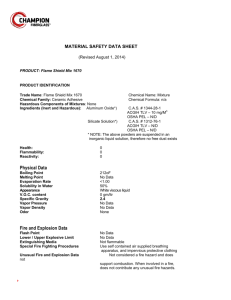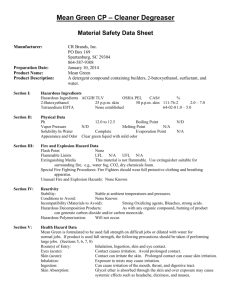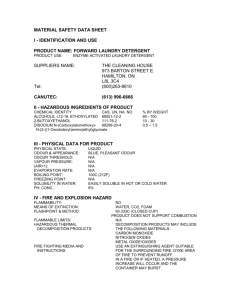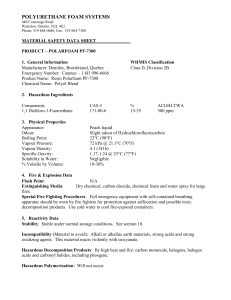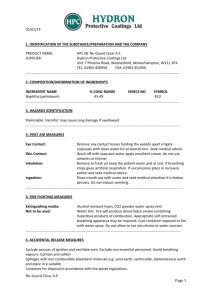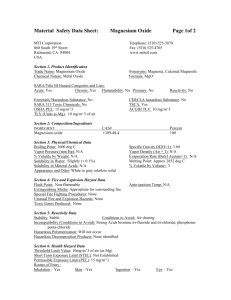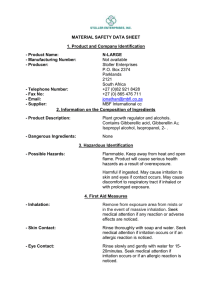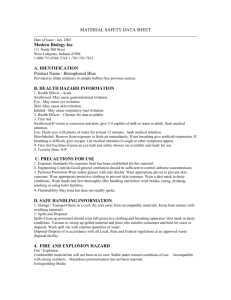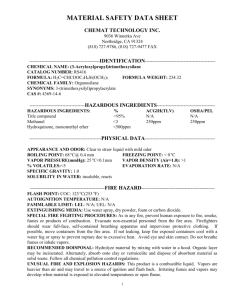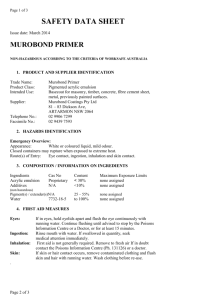M1 - A.C.T. Equipment Sales
advertisement
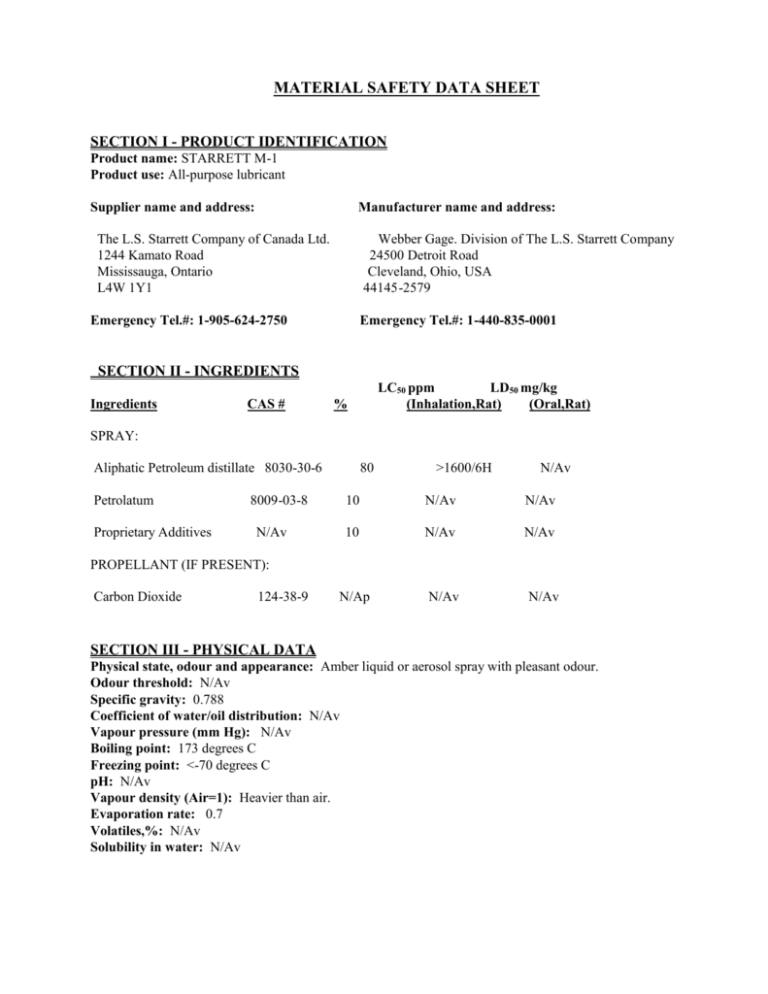
MATERIAL SAFETY DATA SHEET SECTION I - PRODUCT IDENTIFICATION Product name: STARRETT M-1 Product use: All-purpose lubricant Supplier name and address: Manufacturer name and address: The L.S. Starrett Company of Canada Ltd. 1244 Kamato Road Mississauga, Ontario L4W 1Y1 Webber Gage. Division of The L.S. Starrett Company 24500 Detroit Road Cleveland, Ohio, USA 44145-2579 Emergency Tel.#: 1-905-624-2750 Emergency Tel.#: 1-440-835-0001 SECTION II - INGREDIENTS Ingredients CAS # LC50 ppm LD50 mg/kg (Inhalation,Rat) (Oral,Rat) % SPRAY: Aliphatic Petroleum distillate 8030-30-6 Petrolatum Proprietary Additives 8009-03-8 N/Av 80 >1600/6H N/Av 10 N/Av N/Av 10 N/Av N/Av N/Ap N/Av PROPELLANT (IF PRESENT): Carbon Dioxide 124-38-9 N/Av SECTION III - PHYSICAL DATA Physical state, odour and appearance: Amber liquid or aerosol spray with pleasant odour. Odour threshold: N/Av Specific gravity: 0.788 Coefficient of water/oil distribution: N/Av Vapour pressure (mm Hg): N/Av Boiling point: 173 degrees C Freezing point: <-70 degrees C pH: N/Av Vapour density (Air=1): Heavier than air. Evaporation rate: 0.7 Volatiles,%: N/Av Solubility in water: N/Av SECTION IV - FIRE AND EXPLOSION DATA Conditions of flammability: Combustible. Can be ignited if moderately preheated. Vapours are heavier than air and may travel along the ground or be moved by ventilation and be ignited by heat, pilot lights, flames or other ignition sources at distant locations. Never use welding or cutting torches on or near drum (even when empty) because product or residue can ignite explosively. Means of extinction: Foam, carbon dioxide, dry chemical. Sensitivity to mechanical impact/static discharge: Not sensitive to mechanical impact. However, if the product or vapours are exposed to spark, they can ignite explosively. Flash point (Method): 53 degrees C (Tagg Open Cup) Upper flammable limits (% by volume): N/Av Lower flammable limits (% by volume): N/Av Auto-ignition temperature: N/Av Hazardous combustion products: Combustion may produce carbon dioxide, carbon monoxide, and other toxic or acrid fumes. SECTION V - REACTIVITY DATA Stability: Stable under normal conditions. Hazardous polymerization does not occur. Incompatible materials: Strong oxidizing materials (such as nitric acid, peroxide, etc.) Conditions of reactivity: Does not react with water. May ignite or decompose if exposed to heat, sparks or flame. Hazardous decomposition products: See "Hazardous combustion products". SECTION VI - TOXICOLOGICAL PROPERTIES *** Routes of exposure and acute effects *** LD50 of material: N/Av LC50 of material: N/Av Exposure limit: TLV: 100 ppm for petroleum distillates. Inhalation: Can cause severe respiratory irritation, coughing and difficulty breathing. Skin: Can cause moderate irritation, defatting of skin. Eyes: May cause severe eye irritation, blurred vision. Ingestion: Causes irritation of mouth and throat, nausea, gastrointestinal disturbance. WARNING! Aspiration (breathing in) of even a small amount of vomited material can cause a potentially fatal pneumonitis (inflammation of the lungs). Chronic effects: Prolonged or repeated skin contact can cause dermatitis. Carcinogenicity: Not listed as a carcinogen by IARC or ACGIH-TLV. Teratogenicity, mutagenicity, reproductive effects: N/Av Sensitization to material: N/Av Synergistic materials: N/Av SECTION VII - FIRST AID Inhalation: Remove victim to fresh air. If breathing stopped, give artificial respiration. Keep victim warm and quiet. Call a physician immediately. Skin: Wash affected area with mild soap and water. If irritation persists, call a physician. Eyes: Flush with lukewarm running water for 15 minutes, holding eyelids open. Call a physician immediately Ingestion: DO NOT INDUCE VOMITING. If vomiting occurs naturally, keep victim's head lower than hips to prevent aspiration. Keep victim warm and quiet. Call a physician immediately. SECTION VIII - PREVENTIVE MEASURES Spill, leak or release: Small spills - Absorb liquid on absorbent material, place in fume hood and allow to evaporate, or dispose of a flammable waste in appropriate container. Large spills - Eliminate all ignition sources. Stop spill at source and dike area to prevent spreading. Pump liquid to salvage tank. Prevent runoff to sewers and streams. Persons not wearing protective equipment should be excluded from the spill area until clean-up is completed. Waste disposal: Comply with all federal, provincial and local regulations regarding disposal. Usual methods include liquid incineration of disposal in a regulated hazardous waste landfill. ***PROTECTIVE EQUIPMENT*** Respiratory protection: If the TLV is exceeded, wear a NIOSH/MSHA approved self-contained breathing apparatus with full facepiece operated in a pressure-demand mode. Ventilation: General or local ventilation as needed to keep contamination below the TLV. Protective gloves: Impervious gloves such as BUNA-N. Eye protection: Chemical splash goggles. Other protective equipment: Impervious clothing and boots to prevent prolonged skin contact. Maintain an eyewash station in the work area. ***STORAGE AND HANDLING*** Handling procedures and equipment: Avoid skin or eye contact. Avoid breathing vapours or spray particles. Keep away from heat, flame and strong oxidizers. Do not store aerosol cans above 49 degrees C or incinerate. All containers of this material may be hazardous when empty due to product residues. All precautions on this MSDS must be observed when handling them. Storage requirements: Store in a cool, dry, well-ventilated area, away from incompatibles such as oxidizers Special shipping information: N/Av Additional notes or references: Abbreviations: N/Av: N/Ap: IARC: ACGIH: NIOSH: MSHA: TLV-TWA: Not available Not applicable International Agency for Research on Cancer American Conference of Governmental Industrial Hygienists National Institute for Occupational Health and Safety Mine Safety and Health Adminstration Threshold Limit Values, Time Weighted Average References: 1. Van Nostrand Reinhold, Dangerous Properties of Industrial Materials, Seventh Edition, N. Irving Sax. 2. Canadian Centre for Occupational Health and Safety. RTECS (Registry of Toxic Effects) database. 3. ACGIH, Threshold Limit Values and Biological Exposure Indices for 1987-88. 4. International Agency for Research on Cancer Monographs, Supplement 7, 1988. SECTION IX - PREPARATION INFORMATION Prepared by: The L.S. Starrett Company of Canada Ltd. Preparation date: January, 2003 Telephone: 1-905-624-2750 Fax: 1-905-624-0901
